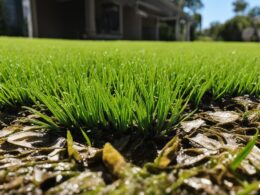If you dream of having a lush green yard, investing in proper lawn care is essential. One aspect to consider when planning your lawn care budget is the cost to seed a lawn. By understanding the factors that influence this cost and making smart decisions, you can achieve the beautiful yard you desire without breaking the bank.
The cost to seed a lawn can vary based on factors such as the size of your lawn, the type of grass seed, and your region. On average, the cost of reseeding a lawn ranges from $0.05 to $0.25 per square foot. This cost includes factors like soil preparation, equipment rental, and the cost of the grass seed itself.
To plan your budget smartly, it’s important to evaluate these factors. Consider the size of your lawn and the amount of grass seed you’ll need. Additionally, research the different types of grass seed available and their associated costs. Take into account any necessary soil preparation, such as removing existing vegetation or adding topsoil, which can impact the overall cost. If equipment rental is required for the process, factor that expense into your budget as well.
By carefully considering these aspects and estimating the costs involved, you can create a realistic budget for seeding your lawn. This approach will ensure that you achieve a lush, green yard while staying within your financial means.
Stay tuned for the next sections of this article, where we will delve deeper into the factors affecting the cost to seed a lawn, provide an average cost breakdown, and share tips to save on lawn seeding costs. We will also discuss smart lawn care practices and explore creative alternatives to traditional grass lawns. Finally, we will compare the cost of seeding versus sodding to help you make an informed decision for your lawn care investment.
Factors Affecting the Cost to Seed a Lawn
The cost to seed a lawn can be influenced by several factors. First and foremost, the size of your lawn plays a significant role in determining the overall cost. The larger the lawn, the more grass seed you will need, which directly impacts the expense. Additionally, the type of grass seed you choose can also affect the cost. Different varieties of grass seed come at varying price points, with some being more expensive than others.
Another factor to consider is the region you are in. Certain grass species thrive better in specific climates, and the availability and cost of these grass seeds can vary depending on your location. It’s essential to select grass seeds that are well-suited to your region’s climate for optimal results.
Soil preparation is another key factor that can contribute to the cost of seeding a lawn. This includes tasks such as removing existing vegetation or adding topsoil to create a favorable environment for grass seed germination and growth. Depending on the condition of your soil, you may need to invest in soil preparation materials or hire professional services.
Lastly, the need for equipment rental can also affect the cost of seeding a lawn. Depending on the size of your lawn and the extent of soil preparation required, you may need to rent equipment such as tillers, aerators, or spreaders to ensure the proper application of grass seed.
Average Cost Breakdown for Seeding a Lawn
When planning to seed a lawn, it’s important to consider the average cost breakdown to ensure you budget accordingly. The cost of grass seed itself typically ranges from $0.10 to $0.50 per square foot, depending on the type of seed you choose. Proper soil preparation is crucial for successful lawn establishment and can cost approximately $0.20 to $0.50 per square foot, including tasks like removing existing vegetation and adding topsoil to create a nutrient-rich environment for the seeds to thrive. Additionally, you may need to factor in the cost of equipment rental, such as a tiller or aerator, which can vary depending on your location and rental duration. It’s essential to consider all these factors to estimate the total cost accurately.
Tips to Save on Lawn Seeding Costs
When it comes to saving on lawn seeding costs, there are several budget-friendly landscaping tips you can follow to keep your expenses in check. By implementing these strategies, you can create a beautiful and vibrant lawn without breaking the bank.
Buy Grass Seed in Bulk
One effective way to save on lawn seeding costs is by purchasing grass seed in bulk. By buying in larger quantities, you can often take advantage of discounted prices. Additionally, consider coordinating with gardening friends or neighbors to share the cost of the bulk purchase. This not only reduces the overall expense but also fosters a sense of community among fellow garden enthusiasts.
Reuse Materials
Another cost-saving measure is to reuse materials whenever possible. Instead of buying brand new tools, consider purchasing gently used equipment from local yard sales or online platforms. Repurposing common household items, such as containers or buckets, can also serve as cost-effective alternatives for planting and landscaping needs. Not only will this approach help you save money, but it also promotes sustainability by reducing waste.
Consider Planting Grass Seed
While using sod provides an instant, established lawn, it can be more expensive compared to planting grass seed. By opting to plant grass seed, you can significantly cut down on costs. Seed is typically less expensive than sod, making it a budget-friendly choice for homeowners. Although it may take some time for the grass to fully establish, the savings are well worth the wait.
Implementing these tips can help you create a lush green yard without straining your budget. By buying grass seed in bulk, reusing materials, and considering grass seed instead of sod, you’ll be able to save on lawn seeding costs while still achieving the beautiful lawn you desire.
Smart Lawn Care Practices to Optimize Your Investment
To optimize your lawn care investment, it’s essential to follow smart lawn care practices. By implementing these practices, you can ensure that your lawn stays healthy and vibrant without overspending on unnecessary treatments or maintenance.
Proper Watering Techniques
One crucial aspect of lawn care is watering. It’s important to strike the right balance – ensuring that your lawn receives enough water without overwatering it. Overwatering can lead to shallow root systems and increased vulnerability to diseases and pests. On the other hand, underwatering can cause dry, brown patches to appear. Water deeply but infrequently, allowing the soil to dry slightly between watering sessions. This encourages deep root growth, making your lawn more resilient.
Fertilizing at the Right Times
Fertilizing your lawn at the right times is another essential practice. Applying fertilizer when your grass needs it the most can promote strong and healthy growth. Consider conducting a soil test to determine any nutrient deficiencies and choose a fertilizer that addresses those specific needs. By fertilizing strategically and using the appropriate products, you can maximize the effectiveness of your lawn care investment.
Implementing Effective Weed Control Methods
Weeds can be a nuisance and compete with your grass for nutrients and water. Implementing effective weed control methods can help prevent weed growth and reduce the need for costly treatments. Regularly inspect your lawn and manually remove any visible weeds. Additionally, consider using targeted weed killers or pre-emergent herbicides to control weed growth. Remember to follow the product instructions carefully to avoid damage to your grass.
Proper Mowing Techniques
Proper mowing is vital for the overall health and appearance of your lawn. Set your mower to the recommended cutting height for your grass type and avoid cutting more than one-third of the grass blade at a time. This promotes strong and healthy grass growth while preventing stress and damage. Regular mowing also helps control weed growth by removing the seed heads before they can spread. Keep your mower blades sharp to ensure clean, even cuts.
By following these smart lawn care practices – proper watering, timely fertilizing, effective weed control, and proper mowing techniques – you can optimize your lawn care investment and enjoy a lush, vibrant yard without overspending.
Creative Alternatives to Traditional Grass Lawns
If you’re looking for alternatives to traditional grass lawns, there are several low-maintenance landscaping options to consider.
One option is to plant native species that are adapted to your region’s conditions. These plants have evolved to thrive in your area’s climate and soil, making them more resistant to drought and pests. By using native species, you can reduce the need for excessive watering and maintenance, ultimately saving you money in the long run.
Another alternative is to incorporate ground cover plants into your landscape design. Ground cover plants are low-growing plants that spread densely, providing a natural and stunning carpet-like effect. They require minimal maintenance, suppress weed growth, and can even help improve soil quality. Some popular ground cover options include creeping thyme, sedum, and moss.
If you’re looking to add a unique touch to your yard, consider creating a rock garden. Rock gardens utilize a variety of rocks and boulders as the main feature, with low-growing plants nestled between them. This type of landscaping not only requires little maintenance but also adds a visually appealing focal point to your outdoor space.
By opting for these alternatives to traditional grass lawns, you can achieve a low-maintenance and cost-effective landscape that contributes to the overall beauty of your yard. Explore different native species and get creative with ground cover plants and rock gardens to create a unique and visually appealing landscape that requires minimal upkeep.
Lawn Seeding Cost vs. Sodding Cost
When it comes to choosing between seeding a lawn and sodding, it’s important to consider the pros and cons of each option. Seeding a lawn is generally a more cost-effective choice compared to sodding. The cost per square foot of grass seed is typically lower than the price of fully established sod. This can be a significant advantage if you have a large lawn or are working within a limited budget.
However, it’s essential to keep in mind that seeding a lawn requires more time and patience. Unlike sod, which gives you an instant impact, seeded lawns take time to establish and fill in. You’ll need to wait for the grass seed to germinate and grow, which can take anywhere from a few weeks to a few months. If you’re looking for quick results or need a fully established lawn for a specific event or occasion, sodding may be the better option.
Sodding allows you to enjoy an instant lush lawn. It gives you an immediate transformation, providing an established look from day one. This can be particularly appealing if you’re hosting an outdoor event or simply want to enjoy a beautiful lawn without the waiting period. However, it’s worth noting that sodding can be more expensive than seeding. The cost of fully grown sod, along with the installation and labor involved, can add up. Additionally, sodded lawns may require extra care and attention during the initial stages to ensure proper root establishment.
Considering your budget, desired timeline, and the level of instant impact you’re looking for will help you make an informed decision. If you’re willing to be patient and allow time for the grass seed to grow, seeding can be a cost-effective option. On the other hand, if you want to enjoy an instant and established lawn, sodding may be worth the additional cost and maintenance.
Can the Cost of Greenhouses Impact the Budget for Seeding a Lawn?
When planning to seed a lawn, it’s important to consider how greenhouse costs explained can impact your budget. Investing in a greenhouse can allow for earlier starts and protected growth, reducing the need to purchase more mature plants. However, the initial cost of a greenhouse should be factored into your seeding budget.
Conclusion
When it comes to achieving a lush, green yard, careful planning and considering cost-effective solutions are essential for managing your lawn care budget. Factors such as lawn size, grass seed type, region, and necessary soil preparation should be taken into account when estimating the cost to seed your lawn. By taking these factors into consideration, you can ensure that you make the most of your lawn care investment without overspending.
In addition to budgeting, following smart lawn care practices can help you maintain a beautiful yard without breaking the bank. Proper watering techniques, timely fertilization, effective weed control, and appropriate mowing heights are just a few examples of practices that can optimize your lawn care investment. By implementing these practices, you can keep your lawn healthy and vibrant while minimizing unnecessary expenses.
Furthermore, exploring alternatives to traditional grass lawns can offer additional cost-effective solutions for achieving an attractive and low-maintenance outdoor space. Native species adapted to your region’s conditions, ground cover plants, or rock gardens can be excellent alternatives that require less maintenance and watering compared to traditional grass lawns.
In conclusion, by considering your lawn care budget, adopting cost-effective solutions, and following smart lawn care practices, you can achieve a lush, green yard while staying within your means. With careful planning and the right approach, you can create a beautiful outdoor space that enhances the aesthetic appeal of your home and brings you joy throughout the year.











